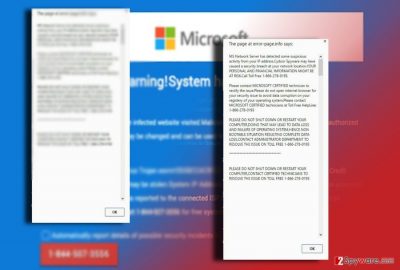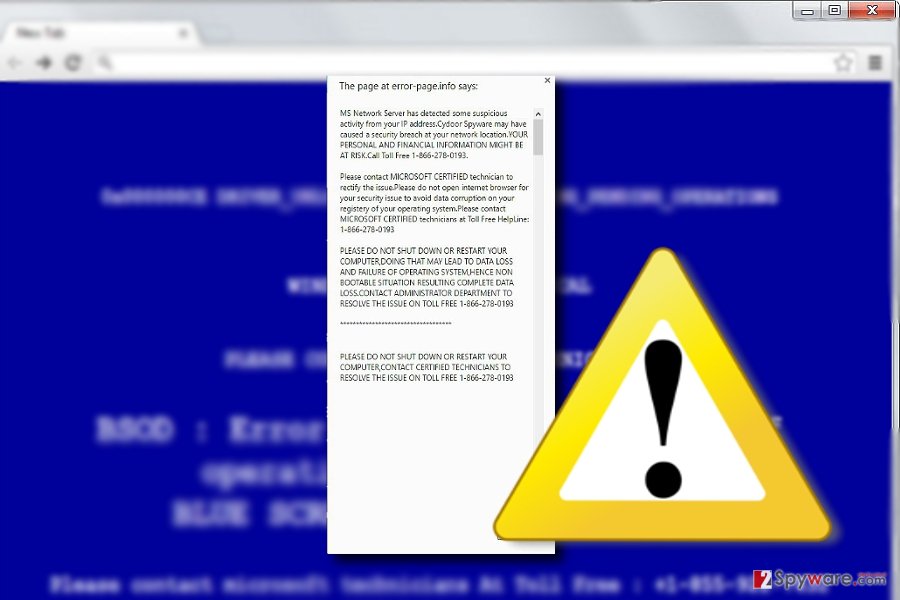“COMPUTER BLOCKED” fake message (Microsoft Support Scam) - Free Instructions
“COMPUTER BLOCKED” fake message Removal Guide
What is “COMPUTER BLOCKED” fake message?
“COMPUTER BLOCKED” fake message tries to persuade you into calling scammers

“COMPUTER BLOCKED” virus functions as a browser-based tech support scam[1]. It is not so elaborate as a PC scams which lock your screen or paralyze the activities of the computer for a while.
Browser-based deceptions require much less time and effort to make. Nonetheless, they might be no less persuasive as PC scams. On the other hand, such felonies can be easily terminated. Click on Prevent this page from creating additional dialogs.
However, there are more bothersome scams appearing. You won’t get rid of it easily simply by clicking on the mentioned button. In order to terminate it, you will need to cancel the page forcefully.
In this article, we will briefly describe key characteristics of such pop-up alerts. If you have run into this website, remove COMPUTER BLOCKED-related web scripts with the assistance of malware elimination tool. e.g. FortectIntego or Malwarebytes.
Scams all over the place
Even if you vary about cyber security while browsing online, there is still a relatively high probability of visiting the website which contains fraudulent elements. The essence of these fake alerts is the same to deceive netizens into dialing the phone number.
Likewise, “Computer Blocked” scam does not differ either. If you call +1-844-392-7021 or any other name, you will be connected to a crook who might crowd you with unnecessary technical information to earn your trust. It is likely that he or she will connect to the device remotely.
Windows Firewall has detected some suspicious activity from your IP address and network connection has been blocked temporarily.
To get it unblocked you need to call on Microsoft Technical Support Desk.
Microsoft Safety & Security Center: +1-844-392-7021
Ring now to get it fixed toll free: +1-844-392-7021
For the supposed “tech support,” they might ask you several dozens of dollars. Additionally, they might foist rogue anti-virus tool which might indeed disturb your PC system integrity.
Additionally, due to “Computer Blocked” redirect virus, you might indeed get redirected to a website which contains malware.
Even if you encounter a more elaborate felony, you can easily distinguish it by looking for a number or email address. No real Microsoft security warnings[2] suggest calling any number or provide any email. 
Distribution peculiarities and prevention
Mostly, you might be redirected to the websites promoting fake alerts while visiting gaming or movie streaming sites.
You might recall that movie play buttons perform their original function only from the third or fourth attempt. Before that, multiple popup alerts will cover your screen. Despite how attractive they might look, cancel them right away. Even if you did not manage to escape “Computer Blocked” hijack, shut down the tab.
Speaking of PC-based tech support scams, they spread with the assistance of exploit kits or similar malicious hacking tools. You should be also cautious while installing a new application. As it is common practice to disguise virtual infection in file converters or download accelerators.
Eliminate “Computer Blocked” tech support scam
You can easily get rid of this scam. Either click on the button Prevent this page from creating additional dialogs. It is also recommended to clean the browser from the web scripts; you can do it by launching an anti-spyware tool. It will remove “Computer Blocked” virus and related web scripts.
Below, you might find manual instructional practical. They come in handy when performing manual “Computer Blocked”scam removal. On the final note, Estonian users are likely to run into this scam more. They can provide more information on how to encounter malware of sorts in the Estonian version[3] of 2-spyware.
You may remove virus damage with a help of FortectIntego. SpyHunter 5Combo Cleaner and Malwarebytes are recommended to detect potentially unwanted programs and viruses with all their files and registry entries that are related to them.
Getting rid of “COMPUTER BLOCKED” fake message. Follow these steps
Uninstall from Windows
Ussually, such scam targets Windows OS users. Be wary of them. You might apply these instructions to eliminate any possible left scripts related to this scam.
Instructions for Windows 10/8 machines:
- Enter Control Panel into Windows search box and hit Enter or click on the search result.
- Under Programs, select Uninstall a program.

- From the list, find the entry of the suspicious program.
- Right-click on the application and select Uninstall.
- If User Account Control shows up, click Yes.
- Wait till uninstallation process is complete and click OK.

If you are Windows 7/XP user, proceed with the following instructions:
- Click on Windows Start > Control Panel located on the right pane (if you are Windows XP user, click on Add/Remove Programs).
- In Control Panel, select Programs > Uninstall a program.

- Pick the unwanted application by clicking on it once.
- At the top, click Uninstall/Change.
- In the confirmation prompt, pick Yes.
- Click OK once the removal process is finished.
Delete from macOS
Remove items from Applications folder:
- From the menu bar, select Go > Applications.
- In the Applications folder, look for all related entries.
- Click on the app and drag it to Trash (or right-click and pick Move to Trash)

To fully remove an unwanted app, you need to access Application Support, LaunchAgents, and LaunchDaemons folders and delete relevant files:
- Select Go > Go to Folder.
- Enter /Library/Application Support and click Go or press Enter.
- In the Application Support folder, look for any dubious entries and then delete them.
- Now enter /Library/LaunchAgents and /Library/LaunchDaemons folders the same way and terminate all the related .plist files.

Remove from Microsoft Edge
Delete unwanted extensions from MS Edge:
- Select Menu (three horizontal dots at the top-right of the browser window) and pick Extensions.
- From the list, pick the extension and click on the Gear icon.
- Click on Uninstall at the bottom.

Clear cookies and other browser data:
- Click on the Menu (three horizontal dots at the top-right of the browser window) and select Privacy & security.
- Under Clear browsing data, pick Choose what to clear.
- Select everything (apart from passwords, although you might want to include Media licenses as well, if applicable) and click on Clear.

Restore new tab and homepage settings:
- Click the menu icon and choose Settings.
- Then find On startup section.
- Click Disable if you found any suspicious domain.
Reset MS Edge if the above steps did not work:
- Press on Ctrl + Shift + Esc to open Task Manager.
- Click on More details arrow at the bottom of the window.
- Select Details tab.
- Now scroll down and locate every entry with Microsoft Edge name in it. Right-click on each of them and select End Task to stop MS Edge from running.

If this solution failed to help you, you need to use an advanced Edge reset method. Note that you need to backup your data before proceeding.
- Find the following folder on your computer: C:\\Users\\%username%\\AppData\\Local\\Packages\\Microsoft.MicrosoftEdge_8wekyb3d8bbwe.
- Press Ctrl + A on your keyboard to select all folders.
- Right-click on them and pick Delete

- Now right-click on the Start button and pick Windows PowerShell (Admin).
- When the new window opens, copy and paste the following command, and then press Enter:
Get-AppXPackage -AllUsers -Name Microsoft.MicrosoftEdge | Foreach {Add-AppxPackage -DisableDevelopmentMode -Register “$($_.InstallLocation)\\AppXManifest.xml” -Verbose

Instructions for Chromium-based Edge
Delete extensions from MS Edge (Chromium):
- Open Edge and click select Settings > Extensions.
- Delete unwanted extensions by clicking Remove.

Clear cache and site data:
- Click on Menu and go to Settings.
- Select Privacy, search and services.
- Under Clear browsing data, pick Choose what to clear.
- Under Time range, pick All time.
- Select Clear now.

Reset Chromium-based MS Edge:
- Click on Menu and select Settings.
- On the left side, pick Reset settings.
- Select Restore settings to their default values.
- Confirm with Reset.

Remove from Mozilla Firefox (FF)
Remove dangerous extensions:
- Open Mozilla Firefox browser and click on the Menu (three horizontal lines at the top-right of the window).
- Select Add-ons.
- In here, select unwanted plugin and click Remove.

Reset the homepage:
- Click three horizontal lines at the top right corner to open the menu.
- Choose Options.
- Under Home options, enter your preferred site that will open every time you newly open the Mozilla Firefox.
Clear cookies and site data:
- Click Menu and pick Settings.
- Go to Privacy & Security section.
- Scroll down to locate Cookies and Site Data.
- Click on Clear Data…
- Select Cookies and Site Data, as well as Cached Web Content and press Clear.

Reset Mozilla Firefox
If clearing the browser as explained above did not help, reset Mozilla Firefox:
- Open Mozilla Firefox browser and click the Menu.
- Go to Help and then choose Troubleshooting Information.

- Under Give Firefox a tune up section, click on Refresh Firefox…
- Once the pop-up shows up, confirm the action by pressing on Refresh Firefox.

Remove from Google Chrome
Delete malicious extensions from Google Chrome:
- Open Google Chrome, click on the Menu (three vertical dots at the top-right corner) and select More tools > Extensions.
- In the newly opened window, you will see all the installed extensions. Uninstall all the suspicious plugins that might be related to the unwanted program by clicking Remove.

Clear cache and web data from Chrome:
- Click on Menu and pick Settings.
- Under Privacy and security, select Clear browsing data.
- Select Browsing history, Cookies and other site data, as well as Cached images and files.
- Click Clear data.

Change your homepage:
- Click menu and choose Settings.
- Look for a suspicious site in the On startup section.
- Click on Open a specific or set of pages and click on three dots to find the Remove option.
Reset Google Chrome:
If the previous methods did not help you, reset Google Chrome to eliminate all the unwanted components:
- Click on Menu and select Settings.
- In the Settings, scroll down and click Advanced.
- Scroll down and locate Reset and clean up section.
- Now click Restore settings to their original defaults.
- Confirm with Reset settings.

Delete from Safari
Remove unwanted extensions from Safari:
- Click Safari > Preferences…
- In the new window, pick Extensions.
- Select the unwanted extension and select Uninstall.

Clear cookies and other website data from Safari:
- Click Safari > Clear History…
- From the drop-down menu under Clear, pick all history.
- Confirm with Clear History.

Reset Safari if the above-mentioned steps did not help you:
- Click Safari > Preferences…
- Go to Advanced tab.
- Tick the Show Develop menu in menu bar.
- From the menu bar, click Develop, and then select Empty Caches.

After uninstalling this potentially unwanted program (PUP) and fixing each of your web browsers, we recommend you to scan your PC system with a reputable anti-spyware. This will help you to get rid of “COMPUTER BLOCKED” fake message registry traces and will also identify related parasites or possible malware infections on your computer. For that you can use our top-rated malware remover: FortectIntego, SpyHunter 5Combo Cleaner or Malwarebytes.
How to prevent from getting malware
Do not let government spy on you
The government has many issues in regards to tracking users' data and spying on citizens, so you should take this into consideration and learn more about shady information gathering practices. Avoid any unwanted government tracking or spying by going totally anonymous on the internet.
You can choose a different location when you go online and access any material you want without particular content restrictions. You can easily enjoy internet connection without any risks of being hacked by using Private Internet Access VPN.
Control the information that can be accessed by government any other unwanted party and surf online without being spied on. Even if you are not involved in illegal activities or trust your selection of services, platforms, be suspicious for your own security and take precautionary measures by using the VPN service.
Backup files for the later use, in case of the malware attack
Computer users can suffer from data losses due to cyber infections or their own faulty doings. Ransomware can encrypt and hold files hostage, while unforeseen power cuts might cause a loss of important documents. If you have proper up-to-date backups, you can easily recover after such an incident and get back to work. It is also equally important to update backups on a regular basis so that the newest information remains intact – you can set this process to be performed automatically.
When you have the previous version of every important document or project you can avoid frustration and breakdowns. It comes in handy when malware strikes out of nowhere. Use Data Recovery Pro for the data restoration process.
- ^ Pedro Hernandez . Microsoft Enlists AI in Fight Against Tech Support Scams. eWeek. Technology News, Tech Product Reviews, Research and Enterprise Analysis.
- ^ Victoria Woollaston. Four people are arrested in the UK in connection with the Microsoft support scam. Wired. Future Science, Culture and Technology.
- ^ Kuidas eemaldada arvutiviirused. IT-uudised ja viiruse eemaldamise juhendid.























